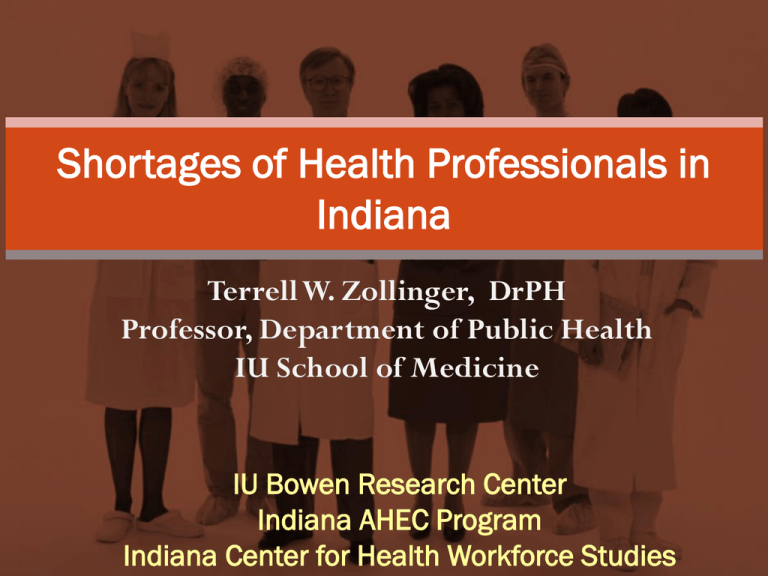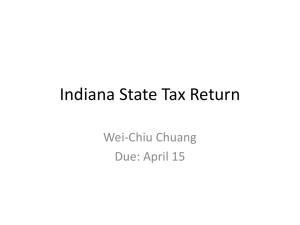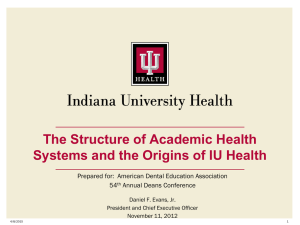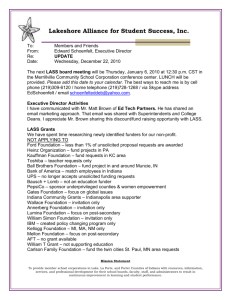Resource - Indiana Rural Health Association
advertisement

Shortages of Health Professionals in Indiana Terrell W. Zollinger, DrPH Professor, Department of Public Health IU School of Medicine IU Bowen Research Center Indiana AHEC Program Indiana Center for Health Workforce Studies Overview What does “shortage” mean? How do we determine if there is a shortage? What are the driving forces? Do we have shortages in Indiana? So what? Are there solutions? What does “shortage” mean? Technically, a shortage occurs when DEMAND is greater than the SUPPLY For the healthcare workforce, we are concerned when access to health care is a barrier because: There are no local providers of the health care needed The local providers can’t provide the care needed because: They are too busy with existing patients and it will take too long to get an appointment The patient has insurance that the provider won’t accept How do we determine if there is a shortage? “Supply” method – compare the ratio in the area with the recommended ratio per 100,000 population “Demand” method – count the unfilled positions in the area “Opinion” method – perceived need for health professionals “Barrier” method – survey population to determine if access to specific types of care is a barrier “Health Status” method – compare health status measures in the area that should be affected by access to providers to a standard or ideal value of health status (e.g. Low rates of first trimester entry into prenatal care, high rates of hospital admissions for preventable causes) Others… Forces driving demand Growth of the Indiana population 18% growth from 1980 to 2010 Aging of the Indiana population Those over age 65 will double by 2030 Those over age 65 make twice as many physician visits compared to those under age 65 Major and chronic illnesses are much more prevalent among those over age 65 Public expectations Baby boomers have more resources Baby boomers have higher expectations and value health care Rates of obesity and the resultant diseases, such as diabetes, are rising very fast Advances in medicine will likely increase service demand Forces driving supply Low growth of health professions training programs Aging of the health professions workforce – partial and full retirements Gender and generational differences in hours spent providing care Federal and state policies restrict immigration of foreign trained health professionals Do we have shortages in Indiana? Where do we stand? Half (54%) of Indiana counties are designated as Medically Underserved Areas in whole or in part 38% of Indiana counties are designated Mental Health Professional Shortage Areas representing 1,097,313 individuals or 17.5% of the state’s population 30% of Indiana counties are designated Primary Care Health Professional Shortage Areas, compromising 836,638 individuals or 13.4% of the state’s population 14% of Indiana counties are designated Dental Health Professional Shortage Areas, affecting 505,696 individuals or 8.1% of the state’s population Shortages of Dentists Based on Supply – of General Dentists: ByShortages Region (recommended is US average) NWI 380 AHEC Region NEI 360 SE/SCI 258 MICI 234 WCI 109 SWI 108 0 50 100 150 200 Number of Dentists needed 1,449 Total 250 300 350 400 Public health burden Higher health care costs Worse health outcomes, including premature deaths Lack of continuity in patient care Preventable emergency department visits and hospitalizations Lower quality of life Loss of productivity Increased health insurance premiums, co-pays, deductibles Increased costs to produce goods and services passed on Expand training capacity Increase number of training programs and class sizes Increase in remote teaching technologies Increasing “teaching faculty” numbers, including part-time and adjunct teaching faculty Increasing “teaching faculty” pay for critical health care training programs Redesign training programs Revise admission criteria to favor applicants with factors predictive of choosing primary care and practicing in areas of need Establish rural and community-based health training programs and clinical rotations for primary care professionals Require clinical training experiences in rural and urban inner-city primary care, medically underserved settings for health care students Focus on recruitment and retention Offer financial aid incentives for health care students and professionals who commit to serving in areas of need Increase awareness of recruitment programs Expand efforts to support the ability of providers to continue practicing in areas of need Enhance payment for preventive/primary care, particularly to underserved populations Thanks…







